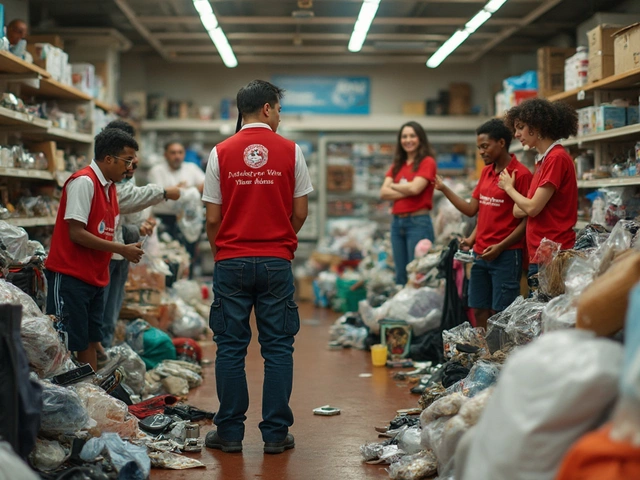Best Places for Homeless Support: Finding a Shelter That Works
Finding the right place to stay when you’re homeless can seriously shape your day-to-day life. Some cities and shelters make it way easier to get back on your feet than others. Not every shelter is created equal—some offer a warm meal, free showers, lockers for your stuff, and even job help, while others just give you a mat on the floor for a night. Knowing where to go can make a tough situation way less overwhelming.
First thing to know: don’t just look for the closest spot. The best shelters usually come with a network—think counselors, case workers, even clinics right inside. A few cities stand out (for both the good and the bad) when it comes to these kinds of support. If you don’t have anyone to ask, lots of libraries have up-to-date lists or social workers who know the local scene. It might sound simple, but sometimes a call to a 2-1-1 line or a quick stop at a library desk can steer you to a spot that actually cares about helping people, not just housing them for a night.
- What Makes a Shelter 'The Best'
- Cities Known for Helpful Shelters
- Day Centers, Night Shelters, and More
- Safety First: What to Watch For
- Useful Tips for Navigating Shelters
- Getting Support Beyond a Bed
What Makes a Shelter 'The Best'
When you’re looking for homeless shelters, it’s not always about the building or location. What really sets the best apart? It boils down to safety, good staff, quality services, and respect. You want a spot that isn’t just a bed for the night but a real launching pad for getting out of a tough situation.
The best shelters feel safe—there’s rules, but they’re there to protect everyone, not to make life harder. Look for places that have security, and most importantly, a clear way to report any problems. No one should feel at risk just trying to sleep.
Services are make-or-break. The top shelters offer more than a meal. You’ll find showers, laundry, lockers for your stuff, and people on staff who can help with paperwork or point you to job openings. According to the National Alliance to End Homelessness, “Access to case management, mental health care, and stable mail services are lifesavers — not just nice extras.”
"A supportive shelter isn’t just about a roof; it opens a path to real help and hope." — Margot Kushel, MD, UCSF Center for Vulnerable Populations
It also matters how you’re treated. Do staff actually listen? Do they explain the rules? The right place treats people with dignity and acts like you matter. That’s not just common sense—studies out of Boston Medical Center show people get back on their feet faster when they feel respected and welcome.
| Key Feature | Why It Matters |
|---|---|
| Safety | Reduces stress and risk while you sleep |
| On-site Services | Connects you with food, showers, and job help fast |
| Professional Staff | Guides you through paperwork and links you to more help |
| Personal Respect | Boosts mental health and motivation |
So if you’re choosing somewhere to stay, don’t just check bed space—ask about what else is offered, and trust your gut about how the place feels. The right homeless shelter can be a real game changer.
Cities Known for Helpful Shelters
Some places really do a better job with homeless shelters than others. For starters, Salt Lake City has built a solid reputation because of its focus on getting people into housing, not just giving them a spot for the night. Their "Housing First" approach helped drop chronic homelessness by over 90% in the last decade. It's not perfect—and funding comes and goes—but when people talk about real results, Salt Lake is always in the mix.
San Francisco has more resources and drop-in centers than most American cities. Of course, there’s a long wait for some beds and space gets tight, but the variety of options sticks out: specialized shelters for families, LGBTQ+ people, and even programs catering just to young adults. Plus, the city funds mobile showers and free clinics close to main shelter areas. Still, high demand means you’ve got to get in line early or call ahead—many places fill by the afternoon.
Boston’s Pine Street Inn is often singled out as one of the most supportive shelters on the East Coast. It provides not only beds but also meals, addiction help, and a job training unit. Staff offer a clear path to permanent housing, and many who stay there agree that the sense of community beats other options in the area.
- Seattle is well-known for offering night-to-night shelter plus daytime drop-in programs with showers and laundry.
- New York City, by law, must offer a shelter bed to anyone who asks. While some shelters there are bare-bones, many bigger organizations add in mental health support or caseworkers.
- Houston's Coalition for the Homeless has a no-nonsense focus on getting people off the street—and their numbers show a steady drop in encampment populations since 2011.
If you’re weighing options, here’s a quick side-by-side breakdown of what a few major cities offer at their homeless shelters:
| City | Emergency Shelter Beds (approx.) | Extra Services |
|---|---|---|
| Salt Lake City | 1,200 | Counselors, medical clinics, job training |
| San Francisco | 2,400 | Specialized shelters, meal programs, mobile showers |
| Boston | 1,600 | Workforce programs, addiction help, food pantry |
| Seattle | 1,800 | Laundry, caseworkers, outreach teams |
| Houston | 3,000+ | Housing placement, transportation passes, ID help |
Bottom line: bigger cities tend to have more shelters and support, but they’re also busier. The most "helpful" city for you is the one where you find open beds, friendly staff, and a path out of homelessness, not just a place to crash—and those spots are out there if you know where to look.
Day Centers, Night Shelters, and More
Not all homeless shelters are the same, and the hours matter way more than you might think. Some spots just let folks crash overnight, while others open their doors during the day. If you’re new to this, here’s what usually sets them apart:
- Night shelters: These usually open in the evening and kick everyone out early in the morning. It’s a bed for a few hours, sometimes with light snacks or breakfast. Privacy? Not much. But if you need to stay out of the cold, these work.
- Day centers: Think showers, laundry, coffee, and case managers. Some even have phone charging stations and mail service (handy if you’re job-hunting). Big day centers in cities like Seattle or San Francisco often connect people to health clinics, job programs, and city services, all under one roof.
- Transitional shelters: These are for folks who want more than one-night stays. You can get a bed for weeks or even months while you work with staff to find work or housing. Rules are stricter, but you get stability.
- Emergency winter shelters: In spots where winters get rough—like Minneapolis or Chicago—these pop up during the coldest months. They’re lifesavers, especially when other places are full.
Here's a quick look at how day centers and night shelters compare, based on what’s offered in real places:
| Service | Day Center | Night Shelter |
|---|---|---|
| Open Hours | Morning to evening | Evening to early morning |
| Meals | Lunch/snacks, sometimes breakfast | Light dinner, maybe breakfast |
| Showers/Laundry | Usually available | Often not available |
| Case Workers/Support | Often available | Rare |
| Storage Lockers | Sometimes available | Rare |
If you're in a bigger city, chances are you’ll find specialized support services mixed in, like drop-in medical help, legal aid, or budgeting classes. For example, the Bowery Mission in New York mixes hot meals with addiction recovery and job training, while St. Anthony’s in San Francisco makes sure folks can get new clothes, haircuts, and family support alongside lunch. If you plan to use these places, show up early; it’s not unusual for day centers to fill up within an hour.
It helps to map out which homeless shelters do what. Some people split their day: sleep in one shelter, shower at a day center, stash stuff in lockers at another. If you’re not sure where to start, ask at the nearest outreach bus or public library—many libraries in big cities even print out the day’s shelter maps and meal calendars for free. Keeping track of what you need (bed, food, shower, medical care) makes picking the place a lot easier and less stressful.

Safety First: What to Watch For
When you're picking a homeless shelter, safety should come first. Not all shelters have the same vibe. Some are super strict about rules and security, while others feel pretty loose. It's smart to check out a shelter’s safety measures before you commit.
Good shelters watch for everyone’s well-being. They’ll have staff at the entrance, locked doors at night, and often a security guard. The best places take things like fights, harassment, and theft seriously. Ask if they have cameras or rules about who can come in and out. If you hear about people’s belongings getting stolen—or worse, fights breaking out every night—it’s probably a red flag.
Women, LGBTQ+ folks, and people with disabilities sometimes face more risk than others. In 2023, a big survey of New York City shelters found that almost 25% of residents worried about harassment. Many large city shelters have dedicated floors or even whole buildings for women, families, or specific communities, which helps.
- Always ask if there are staff on duty 24/7.
- Find out if there’s a curfew. Curfews help keep the place safe but also mean you can’t leave or return at odd hours.
- See if there’s a way to secure your stuff, like lockers or storage bins. Some shelters offer zip ties or locks for free.
- If you take medication, ask if staff can help you keep it safe or refrigerated if needed.
Here’s what safety features you might want to look for in a homeless shelter:
| Safety Feature | Why It Matters |
|---|---|
| On-site staff/security | Quicker help in emergencies |
| Lockers or secure bins | Protects your valuables |
| Separate sections for women/families | Reduces risk of harassment |
| Visible cameras | Helps calm dangerous behavior |
| Curfews/checks | Keeps the space calm and safe overnight |
If you see or hear about risky stuff, don’t be afraid to look for another shelter if you can. Trust your instincts. And remember, most people just want a safe spot to rest. If you look out for yourself and stick to places with solid rules and staff, you’ll cut your risk way down.
Useful Tips for Navigating Shelters
Stepping into a homeless shelter for the first time can feel pretty overwhelming, but a little know-how goes a long way. The rules and vibe are different at every place, so a few quick tips can seriously smooth things out.
- Ask About Services: Not all shelters offer the same things. Some might provide meals, job help, showers, or even storage for your stuff. Don’t be shy about asking what’s available when you check in.
- Show Up Early: Beds fill up fast, especially during cold months. Many places operate on a first-come, first-served basis, so getting there earlier in the day boosts your chance of snagging a spot.
- Bring the Basics: Keep a small bag with your ID, chargers, any meds, a toothbrush, and extra socks. A lot of shelters get packed, and personal supplies make life a lot easier.
- Protect Your Stuff: Lockers aren’t always available, and theft happens. Keep your important things on you at all times. If there are lockers or safe storage, use them.
- Follow the Rules: Shelters usually have curfews and quiet hours. Breaking rules can mean losing your spot. Sometimes there are strict rules about alcohol and behavior for everyone’s safety.
- Watch for Caseworkers: Shelters with caseworkers can really help if you need guidance, paperwork, or help finding work or housing. If you see one, introduce yourself and ask for their advice. They know the drill and can point you to resources beyond just a bed.
- Use Community Resources: Libraries are goldmines for finding info on longer-term housing, benefits, or free meals. Lots of them even have social workers on staff now.
Here’s a quick look at some common features you’ll run into at different homeless shelters:
| Shelter Feature | How Common? | Why It Matters |
|---|---|---|
| Meal Service | About 65% of U.S. shelters | Free food, no need to hunt for your next meal |
| Storage Lockers | Less than 30% | Safe place for your stuff = peace of mind |
| On-site Caseworkers | About 50% | Help with ID, jobs, benefits, and more |
| Health Clinic Access | Roughly 15% | Quick help for common health issues |
Getting familiar with how homeless shelters work and what’s out there boosts your chances of landing somewhere a bit more comfortable or getting the help to get back on your feet faster.
Getting Support Beyond a Bed
Sleeping indoors is just the start. Good homeless shelters do way more than hand out blankets. If you want to really get on your feet, you should look for places that connect you to food assistance, mental health help, job leads, and medical care. The best shelters don’t just give you a roof—they act like landing pads, giving you tools to move forward.
Some cities run support programs right inside shelter buildings. For example, in Seattle and New York, staff often help with everything from ID replacement to getting signed up for Medicaid. In Los Angeles, a few shelters hold regular visits from lawyers who help with housing rights and legal problems. These extra services matter—a lot. A 2023 report from the National Alliance to End Homelessness says folks who use shelters with on-site services find stable housing 40% faster than those who just get a bed. That’s a game changer.
Here are some typical extra services you might find at top shelters:
- Job training, resume writing workshops, and job fairs
- Group therapy or one-on-one counseling
- On-site medical clinics and mobile health vans
- Help getting food stamps or public aid
- Case managers who make personal plans with you
- Showers, laundry, and phone charging stations
If you end up at a homeless shelter with barely any extra support, don’t give up. Ask staff for referrals to local day centers, charities, or drop-ins. Churches and community groups sometimes do free hot meals, basic health checks, and even laundry days. Don’t forget about public libraries either—they often offer social workers, job-search computers, and a safe spot out of the elements.
Bottom line: Steer toward homeless shelters that are plugged into the local network. The more support around, the higher your odds of not just surviving—but moving on and finding stability.
| Extra Support Provided | Percent of U.S. Shelters (2023) |
|---|---|
| Case Management | 75% |
| Health Care Access | 58% |
| Job Help Programs | 41% |







